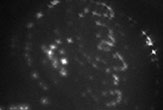
Scientists are working on a tactile sensor that could one day lend a human touch to robotic hands. The new sensor responds to pressure and texture with a sensitivity and spatial resolution comparable to human fingers.
The device, created by Vivek Maheshwari and Ravi Saraf at the University of Nebraska, is detailed in the June 9 issue of the journal Science.
The sensor is a film made of stacked layers of semi-conductive nanoparticles that are separated by layers of a non-conducting material. When pressure is exerted on the film, the layers are pressed together. This releases light and an electric current that can be measured; the amount of light and current emitted depends on the amount of pressure applied.
In one demonstration, the researchers pressed a penny into the sensory film. Pinpricks of light in the shape and outline of President Lincoln's clothes appeared on the film and the letters "TY" in "LIBERTY" on the coin could be made out. The glowing outline was captured by a camera and then fed into a computer.
The new sensor can also operate in an alternative mode that doesn't require a camera and which is just as sensitive, Saraf said.
Better than other sensors
Most robotic systems in use today have so-called binary touch sensors which can only tell if something is touching them or not. Researchers have created more advanced sensors but they have either been difficult to manufacture, are too fragile to withstand real world wear-and-tear or too expensive to produce in significant amounts.
Sign up for the Live Science daily newsletter now
Get the world’s most fascinating discoveries delivered straight to your inbox.
"If you want to make an electronic skin, you will have to figure out how to make it in large areas because one centimeter square is not good enough," Saraf said in a telephone interview. "Our device you can make it over a meter square."
The new sensor potentially overcomes all of the old problems and has a few added benefits to boot, Saraf and colleagues say.
For one thing, it has a finer spatial resolution than other sensors. Where other sensors have a maximum resolution of about 2 millimeters (less than a tenth of an inch), the new sensor can make out objects that are only a few tens of microns in width. One micron is equal to 0.001 millimeters.
The finer resolution raises some intriguing possibilities for future applications, Saraf said.
Robo-surgeons and cancer detectors
The new sensor would be especially useful in medicine, where robots are already routinely used in minimally invasive surgeries. Robot surgeons that could "feel" the way humans do would potentially be even more effective.
The researchers have also filed a patent for an even more ambitious use of their technology.
"The resolution of our sensor is about 10 to 40 microns. Well, the human cell is about 10 microns," Saraf told LiveScience. "If you imagine a tissue in which certain cells are cancerous, and if you imagine that cancerous cells have a different texture than normal cells, you could sense the cancerous cells."
Saraf envisions a future in which surgeons could test for cancer even as they're operating by placing a piece of biopsied tissue onto a sensor-equipped sheet of glass.
"They could determine what direction they need to cut, whether they've cut enough or whether they need to cut more," Saraf said.










